货币金融学基础习题17章
《货币金融学》课后习题答案
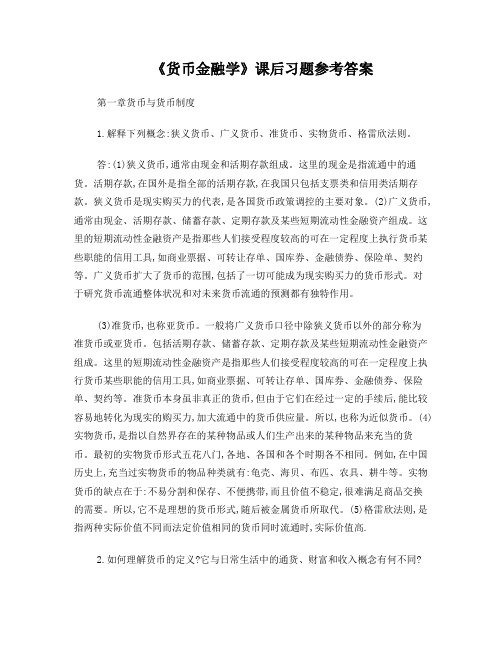
《货币金融学》课后习题参考答案第一章货币与货币制度1.解释下列概念:狭义货币、广义货币、准货币、实物货币、格雷欣法则。
答:(1)狭义货币,通常由现金和活期存款组成。
这里的现金是指流通中的通货。
活期存款,在国外是指全部的活期存款,在我国只包括支票类和信用类活期存款。
狭义货币是现实购买力的代表,是各国货币政策调控的主要对象。
(2)广义货币,通常由现金、活期存款、储蓄存款、定期存款及某些短期流动性金融资产组成。
这里的短期流动性金融资产是指那些人们接受程度较高的可在一定程度上执行货币某些职能的信用工具,如商业票据、可转让存单、国库券、金融债券、保险单、契约等。
广义货币扩大了货币的范围,包括了一切可能成为现实购买力的货币形式。
对于研究货币流通整体状况和对未来货币流通的预测都有独特作用。
(3)准货币,也称亚货币。
一般将广义货币口径中除狭义货币以外的部分称为准货币或亚货币。
包括活期存款、储蓄存款、定期存款及某些短期流动性金融资产组成。
这里的短期流动性金融资产是指那些人们接受程度较高的可在一定程度上执行货币某些职能的信用工具,如商业票据、可转让存单、国库券、金融债券、保险单、契约等。
准货币本身虽非真正的货币,但由于它们在经过一定的手续后,能比较容易地转化为现实的购买力,加大流通中的货币供应量。
所以,也称为近似货币。
(4)实物货币,是指以自然界存在的某种物品或人们生产出来的某种物品来充当的货币。
最初的实物货币形式五花八门,各地、各国和各个时期各不相同。
例如,在中国历史上,充当过实物货币的物品种类就有:龟壳、海贝、布匹、农具、耕牛等。
实物货币的缺点在于:不易分割和保存、不便携带,而且价值不稳定,很难满足商品交换的需要。
所以,它不是理想的货币形式,随后被金属货币所取代。
(5)格雷欣法则,是指两种实际价值不同而法定价值相同的货币同时流通时,实际价值高.2.如何理解货币的定义?它与日常生活中的通货、财富和收入概念有何不同?答:(1)货币是日常生活中人们经常使用的一个词,它的含义丰富,在不同的场合有不同的意义。
货币金融学习题册及答案
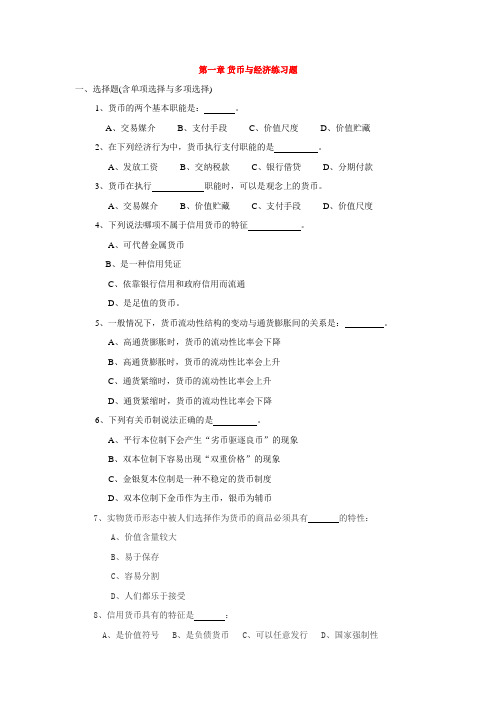
第一章货币与经济练习题一、选择题(含单项选择与多项选择)1、货币的两个基本职能是:。
A、交易媒介B、支付手段C、价值尺度D、价值贮藏2、在下列经济行为中,货币执行支付职能的是。
A、发放工资B、交纳税款C、银行借贷D、分期付款3、货币在执行职能时,可以是观念上的货币。
A、交易媒介B、价值贮藏C、支付手段D、价值尺度4、下列说法哪项不属于信用货币的特征。
A、可代替金属货币B、是一种信用凭证C、依靠银行信用和政府信用而流通D、是足值的货币。
5、一般情况下,货币流动性结构的变动与通货膨胀间的关系是:。
A、高通货膨胀时,货币的流动性比率会下降B、高通货膨胀时,货币的流动性比率会上升C、通货紧缩时,货币的流动性比率会上升D、通货紧缩时,货币的流动性比率会下降6、下列有关币制说法正确的是。
A、平行本位制下会产生“劣币驱逐良币”的现象B、双本位制下容易出现“双重价格”的现象C、金银复本位制是一种不稳定的货币制度D、双本位制下金币作为主币,银币为辅币7、实物货币形态中被人们选择作为货币的商品必须具有的特性:A、价值含量较大B、易于保存C、容易分割D、人们都乐于接受8、信用货币具有的特征是:A、是价值符号B、是负债货币C、可以任意发行D、国家强制性9、价值尺度与价格标准的区别在于:A、内在与外在B、目的与手段C、自发与人为规定D、变化不一样10、货币危机性最大的职能是:A、通手手段B、支付手段C、贮藏手段D、国际货币11、我国的货币层次划分中一般将现金划入层次:A、M0B、M1C、M2D、M312、货币层次控制重点的确定原则有:A、相关性B、可测性C、可控性D、流动性13、虚金本位制也叫:A、金币本位制B、金块本位制C、生金本位制D、金汇兑本位制14、金银复合本位制的主要缺陷是:A、造成价值尺度的多重性B、违反独占性和排他性C、引起兑换比率的波动D、导致币材的匮乏15、金银复本位制向金本位制的过渡方式是。
A、平行本位制B、双本位制C、跛行本位制D、金块本位制16、下列关于货币层次说法正确的是。
货币金融学习题练习
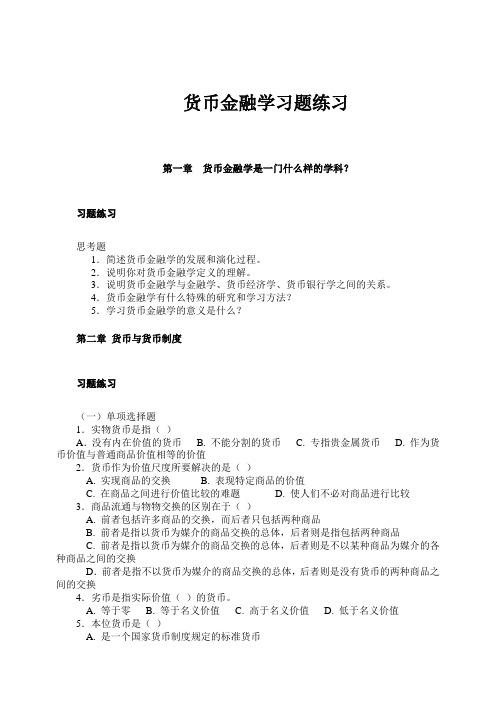
货币金融学习题练习第一章货币金融学是一门什么样的学科?习题练习思考题1.简述货币金融学的发展和演化过程。
2.说明你对货币金融学定义的理解。
3.说明货币金融学与金融学、货币经济学、货币银行学之间的关系。
4.货币金融学有什么特殊的研究和学习方法?5.学习货币金融学的意义是什么?第二章货币与货币制度习题练习(一)单项选择题1.实物货币是指()A.没有内在价值的货币 B. 不能分割的货币 C. 专指贵金属货币 D. 作为货币价值与普通商品价值相等的价值2.货币作为价值尺度所要解决的是()A. 实现商品的交换B. 表现特定商品的价值C. 在商品之间进行价值比较的难题D. 使人们不必对商品进行比较3.商品流通与物物交换的区别在于()A. 前者包括许多商品的交换,而后者只包括两种商品B. 前者是指以货币为媒介的商品交换的总体,后者则是指包括两种商品C. 前者是指以货币为媒介的商品交换的总体,后者则是不以某种商品为媒介的各种商品之间的交换D.前者是指不以货币为媒介的商品交换的总体,后者则是没有货币的两种商品之间的交换4.劣币是指实际价值()的货币。
A. 等于零B. 等于名义价值C. 高于名义价值D. 低于名义价值5.本位货币是()A. 是一个国家货币制度规定的标准货币B. 本国货币当局发行的货币C. 以黄金为基础的货币D. 可以与黄金兑换的货币6.典型的金银复本位制是()A. 金银比价由政府和市场共同决定的金银两本位制B. 金银的比价由市场决定的金银两本位制C. 金银的比价由政府规定的金银两本位制D. 金银比价由银行规定的金银两本位制7.跛行本位制是指()A. 银币的铸造受到控制的金银两本位制B. 金币的铸造受到控制的金银两本位制C. 以金币为本位货币的金银复本位制D. 以银币为本位货币的金银复本位制8.纸币本位制是以()的货币制度。
A. 银行券为本位货币B. 可以自由兑换黄金的本位货币C. 信用货币为本位货币D. 纸币为本位货币9.典型的金本位制是()A. 金块本位制B. 金汇兑本位制C. 虚金本位制D. 金币本位制10.本位货币在商品流通和债务支付中具有()的特点。
《货币金融学》课后习题答案
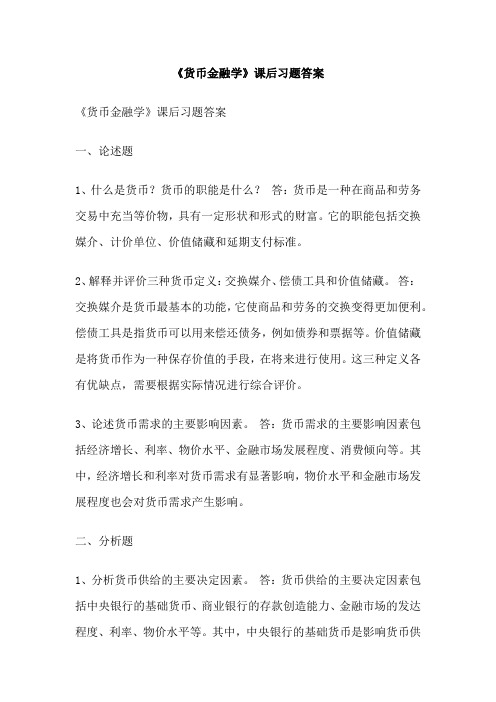
《货币金融学》课后习题答案《货币金融学》课后习题答案一、论述题1、什么是货币?货币的职能是什么?答:货币是一种在商品和劳务交易中充当等价物,具有一定形状和形式的财富。
它的职能包括交换媒介、计价单位、价值储藏和延期支付标准。
2、解释并评价三种货币定义:交换媒介、偿债工具和价值储藏。
答:交换媒介是货币最基本的功能,它使商品和劳务的交换变得更加便利。
偿债工具是指货币可以用来偿还债务,例如债券和票据等。
价值储藏是将货币作为一种保存价值的手段,在将来进行使用。
这三种定义各有优缺点,需要根据实际情况进行综合评价。
3、论述货币需求的主要影响因素。
答:货币需求的主要影响因素包括经济增长、利率、物价水平、金融市场发展程度、消费倾向等。
其中,经济增长和利率对货币需求有显著影响,物价水平和金融市场发展程度也会对货币需求产生影响。
二、分析题1、分析货币供给的主要决定因素。
答:货币供给的主要决定因素包括中央银行的基础货币、商业银行的存款创造能力、金融市场的发达程度、利率、物价水平等。
其中,中央银行的基础货币是影响货币供给的最重要因素,商业银行的存款创造能力也会对货币供给产生显著影响。
此外,金融市场的发展程度和利率也会对货币供给产生影响。
2、分析货币政策的影响因素及其传导机制。
答:货币政策的影响因素包括经济增长、通货膨胀、就业情况、国际收支状况等。
其传导机制包括货币渠道和信用渠道。
其中,货币渠道是通过调整货币供应量来影响利率,进而影响投资和总产出。
信用渠道则是通过影响银行贷款的可得性来影响投资和总产出。
三、计算题1、假设某国基础货币为1000亿美元,活期存款的法定准备金率为0.1%,现金漏损率为0.2%,请计算该国商业银行的存款创造能力。
答:根据商业银行的存款创造能力公式,存款=1/法定准备金率 - 现金漏损率,可计算出该国商业银行的存款创造能力为990亿美元。
2、假设某国经济增长率为3%,物价上涨率为2%,请计算该国的实际经济增长率。
(完整word版)武汉大学货币金融学习题册及答案

第一章货币与经济练习题一、选择题(含单项选择与多项选择)1、货币的两个基本职能是:AC 。
A、交易媒介B、支付手段C、价值尺度D、价值贮藏2、在下列经济行为中,货币执行支付职能的是ABCD 。
A、发放工资B、交纳税款C、银行借贷D、分期付款3、货币在执行 D 职能时,可以是观念上的货币。
A、交易媒介B、价值贮藏C、支付手段D、价值尺度4、下列说法哪项不属于信用货币的特征AD 。
A、可代替金属货币B、是一种信用凭证C、依靠银行信用和政府信用而流通D、是足值的货币。
5、一般情况下,货币流动性结构的变动与通货膨胀间的关系是:BD 。
A、高通货膨胀时,货币的流动性比率会下降B、高通货膨胀时,货币的流动性比率会上升C、通货紧缩时,货币的流动性比率会上升D、通货紧缩时,货币的流动性比率会下降6、下列有关币制说法正确的是 C 。
A、平行本位制下会产生“劣币驱逐良币”的现象B、双本位制下容易出现“双重价格”的现象C、金银复本位制是一种不稳定的货币制度D、双本位制下金币作为主币,银币为辅币7、实物货币形态中被人们选择作为货币的商品必须具有ABCD的特性:A、价值含量较大B、易于保存C、容易分割D、人们都乐于接受8、信用货币具有的特征是ABD :A、是价值符号B、是负债货币C、可以任意发行D、国家强制性9、价值尺度与价格标准的区别在于ABCD :A、内在与外在B、目的与手段C、自发与人为规定D、变化不一样10、货币危机性最大的职能是 B :A、通手手段B、支付手段C、贮藏手段D、国际货币11、我国的货币层次划分中一般将现金划入 A 层次:A、M0 B、M1C、M2D、M312、货币层次控制重点的确定原则有ABC :A、相关性B、可测性C、可控性D、流动性13、虚金本位制也叫 D :A、金币本位制B、金块本位制C、生金本位制D、金汇兑本位制14、金银复合本位制的主要缺陷是ABC :A、造成价值尺度的多重性B、违反独占性和排他性C、引起兑换比率的波动D、导致币材的匮乏15、金银复本位制向金本位制的过渡方式是 C 。
货币金融学习题集(附答案)

货币金融学习题集(附答案)第一章货币与货币制度一、填空题1.货币是长期发展的产物,是表现形式发展的必然结果。
2.在货币产生的过程中,商品价值形式的发展经过、、、等四个阶段。
3.当人们选择用作一般等价物时,货币就产生了。
4.货币作为一种特殊的商品,具有两个重要特征:一是,二是5.货币币材和形制经历了从、、、到等五个阶段的发展过程。
6.金属货币主要沿着两个方向演变:一是经历了由到贵金属的演变;二是经历了由到铸币的演变。
7.货币要成为普遍接受的交换媒介,必须具备两个基本条件:一是;二是8.货币在表现和衡量商品价值时,货币执行职能;在商品的赊销赊购过程,货币执行职能;在退出流通时执行职能;在世界市场上发挥一般等价物作用时执行职能。
9.本位币的面值与金属本身的实际价值是一致的,是货币,是法偿货币。
10.在金属货币流通条件下,流通中的货币量能被,使得与保持相互适应。
11.货币制度相继经历了、、、等四个阶段。
12.银行券是银行发行的一种,即银行保证持有人可以随时向签发银行兑换相应的一种凭证,通常以作为发行准备。
13.铸币的发展有一个从足值到的过程。
16.平行本位制下,金币和银币是按照比价流通,双本位制下,金币和银币则按照比价流通。
17.在跛行本位制下,可以自由铸造而不能自由铸造。
18.在金汇兑本位制下,本币只能先兑换,再兑换19.存储于银行电子计算机系统内可利用银行卡随时提取现金或支付的存款货币称为20.货币金本位制有、、等三种形式。
21.金币本位制的三大特征是指、、22.信用货币主要由现金和存款组成,其中现金是对公众的负债,存款则是对存款人的负债。
23.人民币的发行权属于,是全国惟一的货币发行机关。
24.信用货币的形式有、纸币和等形式。
25.货币成为普遍接受的交换媒介须具备两个基本条件:一是,二是26.规定货币单位包括规定和单位货币的价值两个方面。
27.确定货币单位价值因货币制度不同而有差异:在金属货币流通时代,是确定单位货币所含的;在与黄金挂钩的不兑现货币流通时期,是确定本币单位的,或确定本国货币与的固定比价;黄金非货币化后,则是如何维持本币与的比价。
货币金融学十七

试卷名称:《货币金融学》17一、单项选择题(每小题1分,共12分)1、下列属于资本市场的有(B)A同业拆借市场B股票市场C票据市场D大额可转让定期存单市场2、提高利率会使企业利润相对(A)A减少B增加C不受影响D不一定3、下列不属于货币市场的是(D)A银行同业拆借市场B票据市场C回购市场D证券市场4、中央银行在公开市场上大量抛售有价证券,意味着货币政策(B)A放松B收紧C不变D不一定5、工资率的提高超过劳动生产率的提高引起的通货膨胀属于(B)A 需求拉动型的通货膨胀B 成本推动型的通货膨胀C 结构性通货膨胀D 混合型通货膨胀6、财政赤字导致的通货膨胀,属于(A)类型A需求拉上型B成本推动型C混合推动型D结构型7、目前各国划分货币层次的主要依据普遍是金融资产的(B)A安全性B流动性C收益性D全都是8、浮动汇率制度下,汇率是由(D)决定的。
A货币含金量 B 外汇市场供求状况变动的幅度C中央银行 D 市场供求9、在金本位制下,汇率波动的界限是(D)A黄金书出点B黄金输入点C铸币平价D黄金输入点和输出点10、一张差半年到期的面额为2000远的票据,到银行得到1900元的贴现金额,则年贴现率为(A)A 5%B 10%C 2.56%D 5.12%11、剑桥方程式重视的是货币的( B )A 交易功能B 资产功能C 避险功能D 流动性功能12、下列关于利率对储蓄的影响的表述,正确的是( B )A 在其他条件不变的情况下,利率越高,广义储蓄量越多B 在其他条件不变的情况下,利率越高,狭义储蓄量越多C 在其他条件不变的情况下,利率越高,狭义储蓄量越少D 利率不影响广义储蓄的构成二、多项选择题(每小题2分,共12分)1、一般来说,货币政策具有如下特征(ACDE)A货币政策是一种宏观经济政策B货币政策是一种直接的控制措施C货币政策是一种调整社会总需求的政策D货币政策是一种较长期的经济政策E货币政策是一种逆向调节政策2、商业信用的主要形式有(ABCD)A商品赊销 B 预付定金或货款C货币借款 D 分期付款3、利率按其决定主体的不同可以分为(ACDE)A市场利率 B一般利率 C官定利率D优惠利率 E公定利率4、按交易标的物可以把金融市场划分为(ABCDE)A衍生工具市场 B票据市场 C证券市场D黄金市场 E外汇市场5、商业银行资金来源的筹措主要依靠(ABC)A吸收活期存款 B吸收储蓄存款 C吸收定期存款D发行股票 E发行债券6、典型的信托行为要涉及的关系人有(ABE)A委托人 B 受托人 C中间人 D代理人 E受益人三、判断题(每小题3分,其中判断1分,改错2分,共15分)1、由于现代中央银行是国家机构的一部分,所以中央银行可以向财政部提供直接贷款,弥补财政赤字。
货币金融学习题及答案汇总
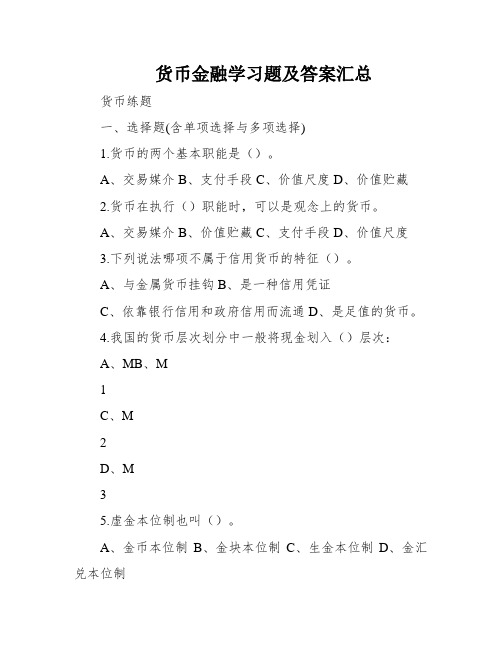
货币金融学习题及答案汇总货币练题一、选择题(含单项选择与多项选择)1.货币的两个基本职能是()。
A、交易媒介B、支付手段C、价值尺度D、价值贮藏2.货币在执行()职能时,可以是观念上的货币。
A、交易媒介B、价值贮藏C、支付手段D、价值尺度3.下列说法哪项不属于信用货币的特征()。
A、与金属货币挂钩B、是一种信用凭证C、依靠银行信用和政府信用而流通D、是足值的货币。
4.我国的货币层次划分中一般将现金划入()层次:A、MB、M1C、M2D、M35.虚金本位制也叫()。
A、金币本位制B、金块本位制C、生金本位制D、金汇兑本位制6.金银复合本位制的主要缺陷是()。
A、造成价值尺度的多重性B、违反独占性和排他性C、引起兑换比率的动摇D、导致币材的匮乏7.金银复本位制向金本位制的过渡方式是()。
A、平行本位制B、双本位制C、跛行本位制D、金块本位制8.下列哪种经济体中,支付体系的效率最低?()。
A、使用黄金作为商品货币的经济体B、易货经济C、使用不兑现纸币的经济体D、使用通货和存款货币的经济体9.下列哪种经济体中,商品和服务可以直接交换成另外的商品和服务?()。
A、使用黄金作为商品货币的经济体B、易货经济C、使用不兑现纸币的经济体D、使用通货和存款货币的经济体10.下列哪个不是货币的目的或功能?()。
A、价值储藏B、交易媒介C、避免通货膨胀的冲击D、代价尺度11.下列哪种是商品货币的例子?()A、5美元钞票B、基于在美国的某银行账户签C、信用卡D、战俘集中营中的香烟E、上述选项都正确12.下列哪种是不兑现纸币的例子?()A、5美圆钞票B、20美圆金币C、原始社会中用做货币的贝壳D、战俘集中营中的香烟二、判断题(在下列题目中,你认为是对的打√,错的打×)1、在市场经济条件下,支票和信用卡都是货币。
( )2、易货经济的效率很低,因为想要达成,必须实现“需求的双重吻合”。
( )3、由于货币具有较好的流动性,通常成为人们价值贮藏的首选。
金融市场与金融机构基础(第17章) 英文版答案

ANSWERS TO QUESTIONS FOR CHAPTER 17(Questions are in bold print followed by answers.)1. What are the three factors contributing to the significant changes in the common market over the past 50 years?The stock markets have also changed since the early 1960s, due to (1) institutionalization (small investors now play only a minor role); (2) changes in government regulations, e.g. disclosure, types of trades, margin requirements; (3) innovations, e.g. computer technology permits program trading.2.a. How does common stock differ from preferred stock?b. Why is preferred stock viewed as a senior corporate security?a.Preferred stock is entitled to a fixed participation in the form of dividends of the earnings ofthe company. Dividends must be declared and ordinarily they are at the discretion of the board. Common stock is entitled to the residual cashflow, and is junior to the preferred stock both in terms of distribution and liquidation preference.b.Preferred stock is considered a senior instrument because dividends must be paid before anydistribution of dividends can be made to the common stockholders. Also, in a liquidation, the preferred stockholders are paid before the common stockholders, who are considered residual claimants.3. What is the difference between ordinary dividends and qualified dividends and how is each treated for tax purposes?Ordinary dividends are taxed at the income tax bracket. Qualified dividends receive preferential tax rate, either 5% or 15%, depending on the individual’s re gular income tax rate.4. What is meant by a long-term capital gain and how is it treated for tax purposes?Long-term capital gains are appreciations in value of the stock that has been held for more than one year. It is entitled to preferential tax rat e, either 5% or 15% depending on the individual’s regular income tax rate.5. The following quote is taken from Wayne H. Wagner, “The Taxonomy of Trading Strategies,” in Katrina F. Sherrerd (ed.), Trading Strategies and Execution Costs (Charlottesville, VA: The Institute of Chartered Financial Analysts, 1988).When a trader decides how to bring an order to the market, he or shemust deal with some very important issues; to me, the most importantis: What kind of trade is this? It could be either an active or a passivetrade. The type of trade will dictate whether speed of execution ismore or less important than cost of execution. In other words, do Iwant immediate trading (a market order); or am I willing to forgo theimmediate trade for the possibility of trading less expensively if I amwilling to “give” on the timing of the trade (a limit order)?a.What is meant by a market order?b.Why would a market order be placed when an investor wants immediate trading?c.What is meant by a limit order?d.What are the risks associated with a limit order?a. A market order is one which is sent to the floor for immediate execution as soon as it isreceived. The buyer or seller receives the market price at the time the trade is executed.b. A market order is executed as soon as possible.c. A limit order is executed when the price reaches a predetermined level.d.The limit may not be reached. The investor cannot predict the timing of the execution.6. Suppose that Mr. Mancuso has purchased a stock for $45 and that he sets a maximum loss that he will accept on this stock of $6.What type of order can Mr. Mancuso place?He will put a sell stop order setting the stop price at $45.7.a.What is a program trade?b.What are the various types of commission arrangements for executing a programtrade and the advantages and disadvantages of each?a. A program trade is an institutional buy or sell of a large basket of stocks.b.If a program trade is executed on an agency basis, commissions are bid for by a group ofbrokerage firms. The advantage is that the commissions tend to be lower, but the disadvantage is that the execution price may not be the best because the impact costs and the potential for front-running. Dealers can also execute a program trade on a principal basis, which means that they buy or sell the amounts from inventory and bear the risk of distribution. The advantage is that the investor knows the trading price in advance, but pays a higher commission.8.a.Explain the mechanics and some key rules of a short sale.b.What restrictions are imposed on short selling activities?a. A short seller borrows the stocks to sell on the market, giving the proceeds of the sale to hisbroker as collateral. Should prices decline he will buy the stocks, return them to the broker and obtain the sales proceeds.b. A short sale must be announced at the time the order is given , and it can occur only after anuptick in the market price of the stock. The short seller is also responsible for paying any dividends due on the stocks before he covers them with a purchase.9. What role does the broker call rate play in a margin purchase?The broker call rate is the rate paid on a bank loan by a broker, who is lending the cash to a customer buying stocks on margin. The broker will normally add a slight service charge to this fee. This rate will affect the margin transaction’s profitability.10.a.What is meant by maintenance margin when stocks are purchased on margin?b.What is meant by debit balance?c.What is meant by credit balance?a.The maintenance margin is the minimum amount of equity in the investor's margin account. Ifthe value of the securities changes enough to erode the value of equity, the investor must provide additional cash to supplement the amount posted.b. A debit balance is the value of the equity less the borrowed amount in a margin purchase.c. A credit balance is the value of the equity plus the borrowed amount in a short sale.11. The following statements are taken from Greta E. Marshall’s article “Execution Costs: The Plan Sponsor’s View,” which appears in Trading Strategies and Execution Costs, published by The Institute of Chartered Financial Analysts in 1988. (The publication is the product of a conference held in New York City on December 3, 1987):a.“There are three components of trading costs. First there a re direct costs which maybe measured—commissions. Second, there are indirect—or market impact—costs.Finally, there are the undefined costs of not trading.” What are market impact costs, and what do you think the “undefined costs of not trading” represent?b.“Market impact, unlike broker commissions, is difficult to identify and measure.”Why is market impact cost difficult to measure?a.Market impact costs are the increases in the bid-ask spread faced by investors who wish toexecute large transactions on a timely basis. Large transactions tend to drive prices in a direction which is adverse to the investor. The “undefined costs of not trading” are opportunity costs that investors face because they failed to make a transaction at the proper time to take advantage of a certain price.b.It is difficult to determine how much of a change in price is due to ordinary market fluctuationsand how of the price rise or drop is due to the costs of absorbing a large trade. The opportunity cost of not trading is also difficult to measure.12.a.What is meant by “soft dollars”?b.What is the concern with soft dollars?a.Soft dollars is compensation to customers in the form of information and preferential timingwhich is “paid” by broker/dealers in exchange for commitments of orde r flow.b.The concern is that the client is not free to shop around for the best bid or best offer, net ofcommissions, for all their transactions, but have to do an agreed amount of transaction volume with the specific broker/dealer. The SEC does not ban soft dollars, but it does regulate it.13.a.What is meant by tick size?b.What is the tick size for common stock?a.The tick size is the minimum price variation for a security.b.The minimum tick size is a penny.14. Why were price limits and collars imposed on stock in the United States?Circuit breakers and trading collar rules halts trading when certain temporary forces, such as emotional trading or a panicked market, threatens stability of market prices. These reforms were made after the stock market crash of October 19, 1987.15.a.What is meant by the circuit breaker rule?b.What is meant by the trading collar rule?a. A circuit breaker is a set of trading rules that stop trading once the market reaches certaindownside benchmarks.b. A trading collar restricts index arbitrage trading. If the DJIA moves up or down 2% fro theprevious closing value, program trading orders to buy or sell the S&P 500 stocks as a part of the index arbitrage strategies must be entered with directions to have the order executions affected in a manner that stabilizes share prices.16. What are the three general types of stock market indicators?Stock market indicators can be classified into three groups: (1) those produced by stock exchanges based on all stocks traded on the exchange; (2) those produced by organizations that subjectively select the stocks to be included in indexes; (3) those where stock selection is based on an objective measure, such as the market capitalization of the company.17. What is the difference between a market-value-weighted index and an equally weighted index?While the stock market indicators rise and fall in unison, several factors differentiate these. One of these is the relative weight assigned to the stock in the index. A market value weighted index is weighting by the market value of the company (capitalization). An equally weighted index will assign weight to each company equally regardless of its market value. The Dow Jones Industrial is a price-weighted index, where as value line composite average is an equally weighted index.18. What are the main features of the S&P 500 common stock index?The S&P 500 index is broad based measurement of changes in stock market conditions of 500 widely held common stocks. The composition of the 500 stocks is flexible. It represents stocks chosen from the two major national stock exchanges and the over-the-counter market.19. “The stocks selected for the S&P 500 are the largest 500 companies in the United States.” Indicate whether you agree or disagree with thi s statement.Disagree .The index captures overall stock market conditions as reflected by a broad range of economic indicators.20. There are participants and analysts in the stock market that are called chartists or technical analysts. What does the theory that the market is weak-form efficient say about these investors’ chances of beating the market?The weak form of the efficient market hypothesis states that past prices cannot predict future trends. Price changes are statistically independent of each other. Thus chartists or technical analysts may not gain superior returns.21. The November 1985 prospectus of the Merrill Lynch Phoenix Fund, Inc., a mutual fund, stated the following investment objective:Based upon the belief that the pricing mechanism of the securitiesmarkets lacks perfect efficiency so that prices of securities of troubledissuers are often depressed to a greater extent than warranted by thecondition of the issuer and that, while investment in such securitiesinvolves a high degree of risk, such investments offer the opportunityfor significant capital gains.What does this strategy assume about the pricing efficiency of the stock market?This strategy assumes pricing inefficiency of the stock market. The prices of these securities do not reflect the true intrinsic value and thus may offer opportunities for reaping abnormal returns.22. Why should an investor who believes that the market is efficient pursue an indexing strategy?This is a strategy that capital market theory suggests captures the efficiency of the market. If the market is truly efficient, investors cannot outperform a market index after adjustments for risk and transaction costs.。
货币金融学习题及答案.(DOC)
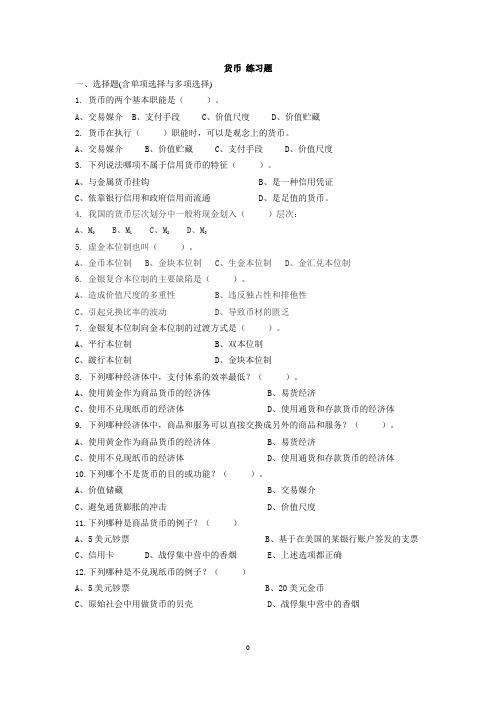
货币练习题一、选择题(含单项选择与多项选择)1. 货币的两个基本职能是()。
A、交易媒介B、支付手段C、价值尺度D、价值贮藏2. 货币在执行()职能时,可以是观念上的货币。
A、交易媒介B、价值贮藏C、支付手段D、价值尺度3. 下列说法哪项不属于信用货币的特征()。
A、与金属货币挂钩B、是一种信用凭证C、依靠银行信用和政府信用而流通D、是足值的货币。
4. 我国的货币层次划分中一般将现金划入()层次:A、M0B、M1C、M2D、M35. 虚金本位制也叫()。
A、金币本位制B、金块本位制C、生金本位制D、金汇兑本位制6. 金银复合本位制的主要缺陷是()。
A、造成价值尺度的多重性B、违反独占性和排他性C、引起兑换比率的波动D、导致币材的匮乏7. 金银复本位制向金本位制的过渡方式是()。
A、平行本位制B、双本位制C、跛行本位制D、金块本位制8. 下列哪种经济体中,支付体系的效率最低?()。
A、使用黄金作为商品货币的经济体B、易货经济C、使用不兑现纸币的经济体D、使用通货和存款货币的经济体9. 下列哪种经济体中,商品和服务可以直接交换成另外的商品和服务?()。
A、使用黄金作为商品货币的经济体B、易货经济C、使用不兑现纸币的经济体D、使用通货和存款货币的经济体10.下列哪个不是货币的目的或功能?()。
A、价值储藏B、交易媒介C、避免通货膨胀的冲击D、价值尺度11.下列哪种是商品货币的例子?()A、5美元钞票B、基于在美国的某银行账户签发的支票C、信用卡D、战俘集中营中的香烟E、上述选项都正确12.下列哪种是不兑现纸币的例子?()A、5美元钞票B、20美元金币C、原始社会中用做货币的贝壳D、战俘集中营中的香烟二、判断题(在下列题目中,你认为是对的打√,错的打×)1、在市场经济条件下,支票和信用卡都是货币。
( )2、易货经济的效率很低,因为想要达成,必须实现“需求的双重吻合”。
( )3、由于货币具有较好的流动性,通常成为人们价值贮藏的首选。
《货币金融学》复习选择题+答案
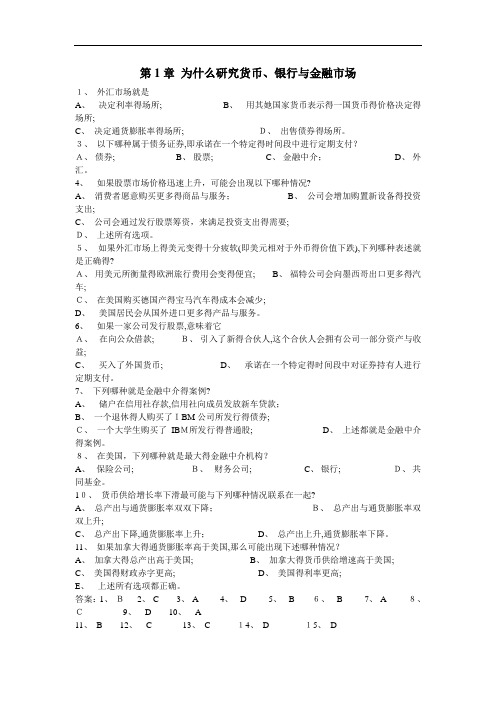
第1章为什么研究货币、银行与金融市场1、外汇市场就是A、决定利率得场所;B、用其她国家货币表示得一国货币得价格决定得场所;C、决定通货膨胀率得场所; D、出售债券得场所。
3、以下哪种属于债务证券,即承诺在一个特定得时间段中进行定期支付?A、债券; B、股票; C、金融中介;D、外汇。
4、如果股票市场价格迅速上升,可能会出现以下哪种情况?A、消费者愿意购买更多得商品与服务;B、公司会增加购置新设备得投资支出;C、公司会通过发行股票筹资,来满足投资支出得需要;D、上述所有选项。
5、如果外汇市场上得美元变得十分疲软(即美元相对于外币得价值下跌),下列哪种表述就是正确得?A、用美元所衡量得欧洲旅行费用会变得便宜;B、福特公司会向墨西哥出口更多得汽车;C、在美国购买德国产得宝马汽车得成本会减少;D、美国居民会从国外进口更多得产品与服务。
6、如果一家公司发行股票,意味着它A、在向公众借款; B、引入了新得合伙人,这个合伙人会拥有公司一部分资产与收益;C、买入了外国货币;D、承诺在一个特定得时间段中对证券持有人进行定期支付。
7、下列哪种就是金融中介得案例?A、储户在信用社存款,信用社向成员发放新车贷款;B、一个退休得人购买了IBM公司所发行得债券;C、一个大学生购买了IBM所发行得普通股; D、上述都就是金融中介得案例。
8、在美国,下列哪种就是最大得金融中介机构?A、保险公司; B、财务公司;C、银行; D、共同基金。
10、货币供给增长率下滑最可能与下列哪种情况联系在一起?A、总产出与通货膨胀率双双下降;B、总产出与通货膨胀率双双上升;C、总产出下降,通货膨胀率上升;D、总产出上升,通货膨胀率下降。
11、如果加拿大得通货膨胀率高于美国,那么可能出现下述哪种情况?A、加拿大得总产出高于美国;B、加拿大得货币供给增速高于美国;C、美国得财政赤字更高;D、美国得利率更高;E、上述所有选项都正确。
答案:1、B2、C 3、A 4、 D 5、 B 6、 B 7、A 8、C9、 D 10、 A11、B 12、C13、C 14、D 15、D第2章金融体系概览1、下述哪种情况属于直接融资?A、您向富兰克林人寿保险公司支付人寿保险得保费,该公司向购房人发放抵押贷款;B、您通过巴尼得经纪人买入通用电气公司得债券;C、您在第一国民银行存入10万美元,该银行向哈德瓦公司发放10万美元得贷款;D、上述情况都不属于直接融资。
米什金《货币金融学》(第11版)笔记和课后习题详解-第5篇 国际金融与货币政策【圣才出品】
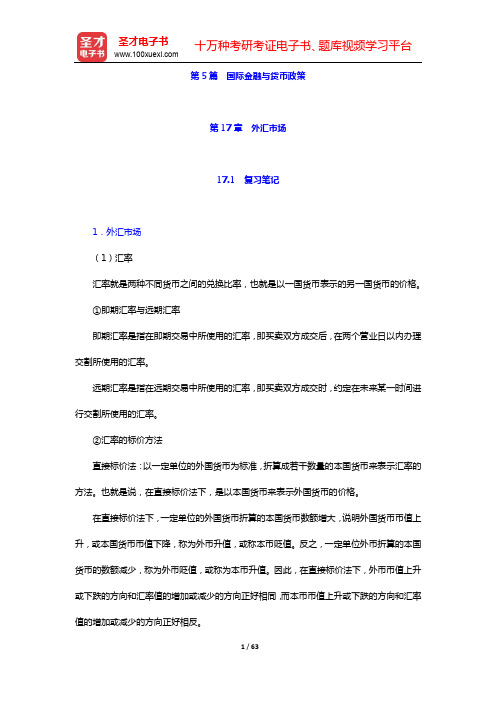
第5篇国际金融与货币政策第17章外汇市场17.1 复习笔记1.外汇市场(1)汇率汇率就是两种不同货币之间的兑换比率,也就是以一国货币表示的另一国货币的价格。
①即期汇率与远期汇率即期汇率是指在即期交易中所使用的汇率,即买卖双方成交后,在两个营业日以内办理交割所使用的汇率。
远期汇率是指在远期交易中所使用的汇率,即买卖双方成交时,约定在未来某一时间进行交割所使用的汇率。
②汇率的标价方法直接标价法:以一定单位的外国货币为标准,折算成若干数量的本国货币来表示汇率的方法。
也就是说,在直接标价法下,是以本国货币来表示外国货币的价格。
在直接标价法下,一定单位的外国货币折算的本国货币数额增大,说明外国货币币值上升,或本国货币币值下降,称为外币升值,或称本币贬值。
反之,一定单位外币折算的本国货币的数额减少,称为外币贬值,或称为本币升值。
因此,在直接标价法下,外币币值上升或下跌的方向和汇率值的增加或减少的方向正好相同,而本币币值上升或下跌的方向和汇率值的增加或减少的方向正好相反。
间接标价法:以一定单位的本国货币为标准,折算成若干数量的外国货币来表示汇率的方法。
即在间接标价法下,以外国货币间接表示本国货币的价格。
在间接标价法下,一定单位的本国货币折算的外国货币数额增多,称为外币贬值,或本币升值。
反之,一定单位的本国货币折算的外币的数额减少,称为外币升值,或本币贬值。
因此,在间接标价法下,外币币值上升或下跌的方向和汇率值的增加或减少的方向正好相反,而本币币值上升或下跌的方向和汇率值的增加或减少的方向正好相同。
(2)汇率的重要意义某国货币升值时(相对其他货币价值上升),该国商品在国外会变贵。
而外国商品在本国则会变便宜(假设两国国内价格水平保持不变);相反,当某国货币贬值时,该国商品在国外将变得更便宜,而外国商品在本国将变贵。
因此,货币升值时,国内生产商向国外出口商品将变得更困难,而外国商品因为价格下降,在国内的竞争力将会提高。
货币金融学习题及参考答案

货币金融学习题及参考答案一.单项选择题1.信用起源于()A、商品交换B、货币流通C、生产社会化D、私有制2.在信用关系的价值运动中,货币执行的职能是( )A、价值尺度B、流通手段C、支付手段 D、储藏手段3.美国同业拆借市场也称()A、贴现市场B、承兑市场C、联邦基金市场 D、外汇交易市场4.资本市场是指()A、短期市场B、一级市场C、发行市场D、长期市场5.劣币是指实际价值( )的货币A、等于零B、等于名义价值 C、高于名义价值D、低于名义价值6.( )是提供金融服务和产品的企业。
A、金融市场B、金融体系C、金融中介 D、金融工具7.货币市场交易与资本市场交易相比较,具有( )的特点。
A、期限短B、流动性低 C、收益率高 D、风险大8.同业拆借市场是金融机构之间为( )而相互融通的市场。
A、减少风险B、提高流动性 C、增加收入D、调剂短期资金余缺9.政策性金融机构是()的金融机构。
A、与商业银行没有区别B、不以营利为目的C、由政府支持不完全以营利为目的D、代表国家财10.本位货币是指( )A、一个国家货币制度规定的标准货币B、本国货币当局发行的货币B、以黄金为基础的货币D、可以与黄金兑换的货币11、由政府或政府金融机构确定并强令执行的利率是()A、公定利率B、一般利率C、官定利率D、固定利率12.信托最突出的特征是对信托财产()的分割A、使用权B、租赁权C、所有权D、代理权13.世界上第一家现代银行――英格兰银行产生于( )A、1690年B、1694年C、1580年D、1587年14.金融监管按大类分可分为证券、保险、( )等监管机构A、信托B、银行C、基金D、投资15."格雷欣法则"这一现象一般发生在()A、银本位制B、金银复本位制C、双本位制D、平行本位制16.假定原始存款为200万元,法定准备率为20%,存款总额可扩大为()A、4000万元B、3600万元C、3000万元D、5000万元17.一张面额为1000元的一年期的汇票,3个月后到期。
货币金融学基础习题17章
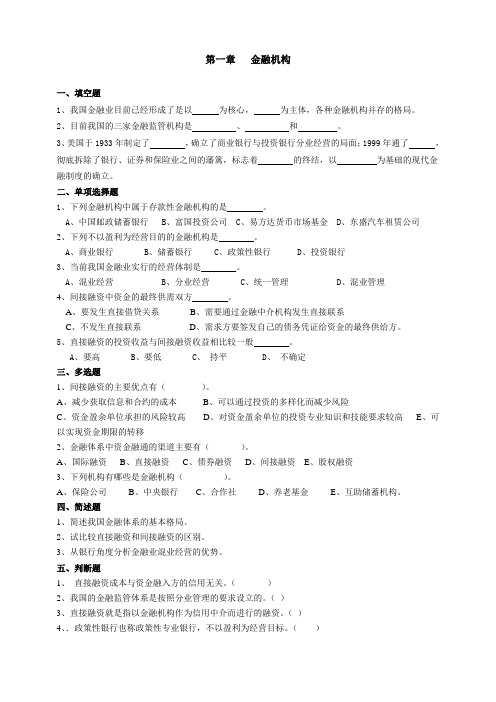
一、填空题1、我国金融业目前已经形成了是以为核心,为主体,各种金融机构并存的格局。
2、目前我国的三家金融监管机构是、和。
3、美国于1933年制定了,确立了商业银行与投资银行分业经营的局面;1999年通了,彻底拆除了银行、证券和保险业之间的藩篱,标志着的终结,以为基础的现代金融制度的确立。
二、单项选择题1、下列金融机构中属于存款性金融机构的是。
A、中国邮政储蓄银行B、富国投资公司C、易方达货币市场基金D、东盛汽车租赁公司2、下列不以盈利为经营目的的金融机构是。
A、商业银行B、储蓄银行C、政策性银行D、投资银行3、当前我国金融业实行的经营体制是。
A、混业经营B、分业经营C、统一管理D、混业管理4、间接融资中资金的最终供需双方。
A、要发生直接借贷关系B、需要通过金融中介机构发生直接联系C、不发生直接联系D、需求方要签发自己的债务凭证给资金的最终供给方。
5、直接融资的投资收益与间接融资收益相比较一般。
A、要高B、要低C、持平D、不确定三、多选题1、间接融资的主要优点有()。
A、减少获取信息和合约的成本B、可以通过投资的多样化而减少风险C、资金盈余单位承担的风险较高D、对资金盈余单位的投资专业知识和技能要求较高E、可以实现资金期限的转移2、金融体系中资金融通的渠道主要有()。
A、国际融资B、直接融资C、债券融资D、间接融资E、股权融资3、下列机构有哪些是金融机构()。
A、保险公司B、中央银行C、合作社D、养老基金E、互助储蓄机构。
四、简述题1、简述我国金融体系的基本格局。
2、试比较直接融资和间接融资的区别。
3、从银行角度分析金融业混业经营的优势。
五、判断题1、直接融资成本与资金融入方的信用无关。
()2、我国的金融监管体系是按照分业管理的要求设立的。
()3、直接融资就是指以金融机构作为信用中介而进行的融资。
()4、.政策性银行也称政策性专业银行,不以盈利为经营目标。
()一、填空题1.按交易标的物划分,金融市场分为、资本市场、外汇市场和。
货币金融学chapter-17英文题
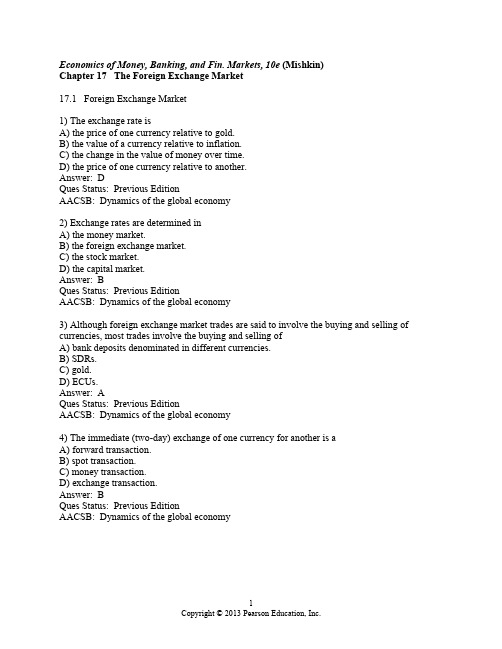
Economics of Money, Banking, and Fin. Markets, 10e (Mishkin)Chapter 17 The Foreign Exchange Market17.1 Foreign Exchange Market1) The exchange rate isA) the price of one currency relative to gold.B) the value of a currency relative to inflation.C) the change in the value of money over time.D) the price of one currency relative to another.Answer: DQues Status: Previous EditionAACSB: Dynamics of the global economy2) Exchange rates are determined inA) the money market.B) the foreign exchange market.C) the stock market.D) the capital market.Answer: BQues Status: Previous EditionAACSB: Dynamics of the global economy3) Although foreign exchange market trades are said to involve the buying and selling of currencies, most trades involve the buying and selling ofA) bank deposits denominated in different currencies.B) SDRs.C) gold.D) ECUs.Answer: AQues Status: Previous EditionAACSB: Dynamics of the global economy4) The immediate (two-day) exchange of one currency for another is aA) forward transaction.B) spot transaction.C) money transaction.D) exchange transaction.Answer: BQues Status: Previous EditionAACSB: Dynamics of the global economy5) An agreement to exchange dollar bank deposits for euro bank deposits in one month is aA) spot transaction.B) future transaction.C) forward transaction.D) deposit transaction.Answer: CQues Status: Previous EditionAACSB: Dynamics of the global economy6) Today 1 euro can be purchased for $1.10. This is theA) spot exchange rate.B) forward exchange rate.C) fixed exchange rate.D) financial exchange rate.Answer: AQues Status: Previous EditionAACSB: Dynamics of the global economy7) In an agreement to exchange dollars for euros in three months at a price of $0.90 per euro, the price is theA) spot exchange rate.B) money exchange rate.C) forward exchange rate.D) fixed exchange rate.Answer: CQues Status: Previous EditionAACSB: Dynamics of the global economy8) When the value of the British pound changes from $1.25 to $1.50, the pound has ________ and the U.S. dollar has ________.A) appreciated; appreciatedB) depreciated; appreciatedC) appreciated; depreciatedD) depreciated; depreciatedAnswer: CQues Status: Previous EditionAACSB: Dynamics of the global economy9) When the value of the British pound changes from $1.50 to $1.25, then the pound has________ and the U.S. dollar has ________.A) appreciated; appreciatedB) depreciated; appreciatedC) appreciated; depreciatedD) depreciated; depreciatedAnswer: BQues Status: Previous EditionAACSB: Dynamics of the global economy10) When the value of the dollar changes from £0.5 to £0.75, then the British pound has________ and the U.S. dollar has ________.A) appreciated; appreciatedB) depreciated; appreciatedC) appreciated; depreciatedD) depreciated; depreciatedAnswer: BQues Status: Previous EditionAACSB: Dynamics of the global economy11) When the value of the dollar changes from £0.75 to £0.5, then the British pound has________ and the U.S. dollar has ________.A) appreciated; appreciatedB) depreciated; appreciatedC) appreciated; depreciatedD) depreciated; depreciatedAnswer: CQues Status: Previous EditionAACSB: Dynamics of the global economy12) When the exchange rate for the Mexican peso changes from 9 pesos to the U.S. dollar to 10 pesos to the U.S. dollar, then the Mexican peso has ________ and the U.S. dollar has ________.A) appreciated; appreciatedB) depreciated; appreciatedC) appreciated; depreciatedD) depreciated; depreciatedAnswer: BQues Status: Previous EditionAACSB: Dynamics of the global economy13) When the exchange rate for the Mexican peso changes from 10 pesos to the U.S dollar to 9 pesos to the U.S. dollar, then the Mexican peso has ________ and the U.S. dollar has ________.A) appreciated; appreciatedB) depreciated; appreciatedC) appreciated; depreciatedD) depreciated; depreciatedAnswer: CQues Status: Previous EditionAACSB: Dynamics of the global economy14) On January 25, 2009, one U.S. dollar traded on the foreign exchange market for about 0.75 euros. Therefore, one euro would have purchased about ________ U.S. dollars.A) 0.75B) 1.00C) 1.33D) 1.75Answer: CQues Status: Previous EditionAACSB: Analytic skills15) On January 25, 2009, one U.S. dollar traded on the foreign exchange market for about 49.0 Indian rupees. Thus, one Indian rupee would have purchased about ________ U.S. dollars.A) 0.02B) 1.20C) 7.00D) 49.0Answer: AQues Status: Previous EditionAACSB: Analytic skills16) On January 25, 2009, one U.S. dollar traded on the foreign exchange market for about 1.15 Swiss francs. Therefore, one Swiss franc would have purchased about ________ U.S. dollars.A) 0.30B) 0.87C) 1.15D) 3.10Answer: BQues Status: Previous EditionAACSB: Analytic skills17) On January 25, 2009, one U.S. dollar traded on the foreign exchange market for about 3.33 Romanian new lei. Therefore, one Romanian new lei would have purchased about ________ U.S. dollars.A) 0.30B) 1.86C) 2.86D) 3.33Answer: AQues Status: Previous EditionAACSB: Analytic skills18) If the U.S. dollar appreciates from 1.25 Swiss franc per U.S. dollar to 1.5 francs per dollar, then the franc depreciates from ________ U.S. dollars per franc to ________ U.S. dollars per franc.A) 0.80; 0.67B) 0.67; 0.80C) 0.50; 0.33D) 0.33; 0.50Answer: AQues Status: Previous EditionAACSB: Analytic skills19) If the British pound appreciates from $0.50 per pound to $0.75 per pound, the U.S. dollar depreciates from ________ per dollar to ________ per dollar.A) £2; £2.5B) £2; £1.33C) £2; £1.5D) £2; £1.25Answer: BQues Status: Previous EditionAACSB: Analytic skills20) If the Japanese yen appreciates from $0.01 per yen to $0.02 per yen, the U.S. dollar depreciates from ________ per dollar to ________ per dollar.A) 100¥; 50¥B) 10¥; 5¥C) 5¥; 10¥D) 50¥; 100¥Answer: AQues Status: Previous EditionAACSB: Analytic skills21) If the dollar appreciates from 1.5 Brazilian reals per dollar to 2.0 reals per dollar, the real depreciates from ________ per real to ________ per real.A) $0.67; $0.50B) $0.33; $0.50C) $0.75; $0.50D) $0.50; $0.67E) $0.50; $0.75Answer: AQues Status: Previous EditionAACSB: Analytic skills22) When the exchange rate for the British pound changes from $1.80 per pound to $1.60 per pound, then, holding everything else constant, the pound has ________ and ________ expensive.A) appreciated; British cars sold in the United States become moreB) appreciated; British cars sold in the United States become lessC) depreciated; American wheat sold in Britain becomes moreD) depreciated; American wheat sold in Britain becomes lessAnswer: CQues Status: Previous EditionAACSB: Analytic skills23) If the dollar depreciates relative to the Swiss francA) Swiss chocolate will become cheaper in the United States.B) American computers will become more expensive in Switzerland.C) Swiss chocolate will become more expensive in the United States.D) Swiss computers will become cheaper in the United States.Answer: CQues Status: Previous EditionAACSB: Analytic skills24) Everything else held constant, when a country's currency appreciates, the country's goods abroad become ________ expensive and foreign goods in that country become ________ expensive.A) more; lessB) more; moreC) less; lessD) less; moreAnswer: AQues Status: Previous EditionAACSB: Analytic skills25) Everything else held constant, when a country's currency depreciates, its goods abroad become ________ expensive while foreign goods in that country become ________ expensive.A) more; lessB) more; moreC) less; lessD) less; moreAnswer: DQues Status: Previous EditionAACSB: Analytic skills17.2 Exchange Rates in the Long Run1) According to the law of one price, if the price of Colombian coffee is 100 Colombian pesos per pound and the price of Brazilian coffee is 4 Brazilian reals per pound, then the exchange rate between the Colombian peso and the Brazilian real is:A) 40 pesos per real.B) 100 pesos per real.C) 25 pesos per real.D) 0.4 pesos per real.Answer: CQues Status: Previous Edition2) The starting point for understanding how exchange rates are determined is a simple idea called ________, which states: if two countries produce an identical good, the price of the good should be the same throughout the world no matter which country produces it.A) Gresham's lawB) the law of one priceC) purchasing power parityD) arbitrageAnswer: BQues Status: Previous Edition3) The ________ states that exchange rates between any two currencies will adjust to reflect changes in the price levels of the two countries.A) theory of purchasing power parityB) law of one priceC) theory of money neutralityD) quantity theory of moneyAnswer: AQues Status: Previous Edition4) The theory of PPP suggests that if one country's price level rises relative to another's, its currency shouldA) depreciate.B) appreciate.C) float.D) do none of the above.Answer: AQues Status: Previous Edition5) The theory of PPP suggests that if one country's price level falls relative to another's, its currency shouldA) depreciate.B) appreciate.C) float.D) do none of the above.Answer: BQues Status: Previous EditionAACSB: Dynamics of the global economy6) The theory of PPP suggests that if one country's price level falls relative to another's, its currency shouldA) depreciate in the long run.B) appreciate in the long run.C) appreciate in the short run.D) depreciate in the short run.Answer: BQues Status: Previous EditionAACSB: Dynamics of the global economy7) The theory of purchasing power parity cannot fully explain exchange rate movements becauseA) all goods are identical even if produced in different countries.B) monetary policy differs across countries.C) some goods are not traded between countries.D) fiscal policy differs across countries.Answer: CQues Status: Previous EditionAACSB: Dynamics of the global economy8) The theory of purchasing power parity states that exchange rates between any two currencies will adjust to reflect changes inA) the trade balances of the two countries.B) the current account balances of the two countries.C) fiscal policies of the two countries.D) the price levels of the two countries.Answer: DQues Status: Previous EditionAACSB: Dynamics of the global economy9) If the real exchange rate between the United States and Japan is ________, then it is cheaper to buy goods in Japan than in the United States.A) greater than 1.0B) greater than 0.5C) less than 0.5D) less than 1.0Answer: AQues Status: Previous EditionAACSB: Dynamics of the global economy10) According to PPP, the real exchange rate between two countries will always equalA) 0.0.B) 0.5.C) 1.0.D) 1.5.Answer: CQues Status: Previous EditionAACSB: Dynamics of the global economy11) The theory of PPP suggests that if one country's price level rises relative to another's, its currency shouldA) depreciate in the long run.B) appreciate in the long run.C) depreciate in the short run.D) appreciate in the short run.Answer: AQues Status: Previous EditionAACSB: Dynamics of the global economy12) In the long run, a rise in a country's price level (relative to the foreign price level) causes its currency to ________, while a fall in the country's relative price level causes its currency to________.A) appreciate; appreciateB) appreciate; depreciateC) depreciate; appreciateD) depreciate; depreciateAnswer: CQues Status: Previous Edition13) If the 2005 inflation rate in Canada is 4 percent, and the inflation rate in Mexico is 2 percent, then the theory of purchasing power parity predicts that, during 2005, the value of the Canadian dollar in terms of Mexican pesos willA) rise by 6 percent.B) rise by 2 percent.C) fall by 6 percent.D) fall by 2 percent.Answer: DQues Status: Previous EditionAACSB: Analytic skills14) Assume that the following are the predicted inflation rates in these countries for the year: 2% for the United States, 3% for Canada; 4% for Mexico, and 5% for Brazil. According to the purchasing power parity and everything else held constant, which of the following would we expect to happen?A) The Brazilian real will depreciate against the U.S. dollar.B) The Mexican peso will depreciate against the Brazilian real.C) The Canadian dollar will depreciate against the Mexican peso.D) The U.S. dollar will depreciate against the Canadian dollar.Answer: AQues Status: Previous EditionAACSB: Analytic skills15) According to the purchasing power parity theory, a rise in the United States price level of 5 percent, and a rise in the Mexican price level of 6 percent causeA) the dollar to appreciate 1 percent relative to the peso.B) the dollar to depreciate 1 percent relative to the peso.C) the dollar to depreciate 5 percent relative to the peso.D) the dollar to appreciate 5 percent relative to the peso.Answer: AQues Status: Previous EditionAACSB: Analytic skills16) Higher tariffs and quotas cause a country's currency to ________ in the ________ run, everything else held constant.A) depreciate; shortB) appreciate; shortC) depreciate; longD) appreciate; longAnswer: DQues Status: Previous EditionAACSB: Dynamics of the global economy17) Lower tariffs and quotas cause a country's currency to ________ in the ________ run, everything else held constant.A) depreciate; shortB) appreciate; shortC) depreciate; longD) appreciate; longAnswer: CQues Status: Previous EditionAACSB: Dynamics of the global economy18) Anything that increases the demand for foreign goods relative to domestic goods tends to________ the domestic currency because domestic goods will only continue to sell well if the value of the domestic currency is ________, everything else held constant.A) depreciate; lowerB) depreciate; higherC) appreciate; lowerD) appreciate; higherAnswer: AQues Status: Previous EditionAACSB: Dynamics of the global economy19) Everything else held constant, increased demand for a country's ________ causes its currency to appreciate in the long run, while increased demand for ________ causes its currency to depreciate.A) imports; importsB) imports; exportsC) exports; importsD) exports; exportsAnswer: CQues Status: Previous EditionAACSB: Dynamics of the global economy20) Everything else held constant, increased demand for a country's exports causes its currency to ________ in the long run, while increased demand for imports causes its currency to________.A) appreciate; appreciateB) appreciate; depreciateC) depreciate; appreciateD) depreciate; depreciateAnswer: BQues Status: Previous EditionAACSB: Dynamics of the global economy21) Everything else held constant, if a factor increases the demand for ________ goods relative to ________ goods, the domestic currency will appreciate.A) foreign; domesticB) foreign; foreignC) domestic; domesticD) domestic; foreignAnswer: DQues Status: Previous EditionAACSB: Dynamics of the global economy22) Everything else held constant, if a factor decreases the demand for ________ goods relative to ________ goods, the domestic currency will depreciate.A) foreign; domesticB) foreign; foreignC) domestic; domesticD) domestic; foreignAnswer: DQues Status: Previous EditionAACSB: Dynamics of the global economy23) An increase in productivity in a country will cause its currency to ________ because it can produce goods at a ________ price, everything else held constant.A) depreciate; lowerB) appreciate; lowerC) depreciate; higherD) appreciate; higherAnswer: BQues Status: Previous EditionAACSB: Dynamics of the global economy24) If, in retaliation for "unfair" trade practices, Congress imposes a 30 percent tariff on Japanese DVD recorders, but at the same time, U.S. demand for Japanese goods increases, then, in the long run, ________, everything else held constantA) the Japanese yen should appreciate relative to the U.S. dollarB) the Japanese yen should depreciate relative to the U.S. dollarC) there is no effect on the Japanese yen relative to the U.S. dollarD) the Japanese yen could appreciate, depreciate or remain constant relative to the U.S. dollar Answer: DQues Status: Previous EditionAACSB: Dynamics of the global economy25) If the U.S. Congress imposes a quota on imports of Japanese cars due to claims of "unfair" trade practices, and Japanese demand for American exports increases at the same time, then, in the long run ________, everything else held constant.A) the Japanese yen will appreciate relative to the U.S. dollarB) the Japanese yen will depreciate relative to the U.S. dollarC) the Japanese yen will either appreciate, depreciate or remain constant against the U.S. dollarD) there will be no effect on the Japanese yen relative to the U.S. dollarAnswer: BQues Status: Previous EditionAACSB: Dynamics of the global economy26) If the inflation rate in the United States is higher than that in Mexico and productivity is growing at a slower rate in the United States than in Mexico, then, in the long run, ________, everything else held constant.A) the Mexican peso will appreciate relative to the U.S. dollarB) the Mexican peso will depreciate relative to the U.S. dollarC) the Mexican peso will either appreciate, depreciate, or remain constant relative to the U.S. dollarD) there will be no effect on the Mexican peso relative to the U.S. dollarAnswer: AQues Status: Previous EditionAACSB: Analytic skills27) If the Brazilian demand for American exports rises at the same time that U.S. productivity rises relative to Brazilian productivity, then, in the long run, ________, everything else held constant.A) the Brazilian real will appreciate relative to the U.S. dollarB) the Brazilian real will depreciate relative to the U.S. dollarC) the Brazilian real will either appreciate, depreciate, or remain constant relative to the U.S. dollarD) there is no effect on the Brazilian real relative to the U.S. dollarAnswer: BQues Status: Previous EditionAACSB: Analytic skills28) Explain the law of one price and the theory of purchasing power parity. Why doesn't purchasing power parity explain all exchange rate movements? What factors determine long-run exchange rates?Answer: With no trade barriers and low transport costs, the law of one price states that the price of traded goods should be the same in all countries. The purchasing power parity theory extends the law of one price to total economies. PPP states that exchange rates should adjust to reflect changes in the price levels between two countries. PPP may fail to fully explain exchange rates because goods are not identical, and price levels include traded and nontraded goods and services. Long-run exchange rates are determined by domestic price levels relative to foreign price levels, trade barriers, import and export demand, and productivity.Ques Status: Previous EditionAACSB: Dynamics of the global economy17.3 Exchange Rates in the Short Run: A Supply and Demand Analysis1) The theory of portfolio choice suggests that the most important factor affecting the demand for domestic and foreign assets isA) the level of trade and capital flows.B) the expected return on these assets relative to one another.C) the liquidity of these assets relative to one another.D) the riskiness of these assets relative to one another.Answer: BQues Status: RevisedAACSB: Dynamics of the global economy2) The ________ suggests that the most important factor affecting the demand for domestic and foreign assets is the expected return on domestic assets relative to foreign assets.A) theory of portfolio choiceB) law of one priceC) interest parity conditionD) theory of foreign capital mobilityAnswer: AQues Status: RevisedAACSB: Dynamics of the global economy3) The theory of portfolio choice suggests that the most important factor affecting the demand for domestic and foreign assets is the ________ on these assets relative to one another.A) interest rateB) riskC) expected returnD) liquidityAnswer: CQues Status: RevisedAACSB: Dynamics of the global economy4) As the relative expected return on dollar assets increases, foreigners will want to hold more ________ assets and less ________ assets, everything else held constant.A) foreign; foreignB) foreign; dollarC) dollar; foreignD) dollar; dollarAnswer: CQues Status: Previous EditionAACSB: Dynamics of the global economy5) When Americans or foreigners expect the return on ________ assets to be high relative to the return on ________ assets, there is a higher demand for dollar assets and a correspondingly lower demand for foreign assets.A) dollar; dollarB) dollar; foreignC) foreign; dollarD) foreign; foreignAnswer: BQues Status: Previous EditionAACSB: Dynamics of the global economy6) When Americans or foreigners expect the return on ________ assets to be high relative to the return on ________ assets, there is a ________ demand for dollar assets, everything else held constant.A) dollar; foreign; constantB) dollar; foreign; higherC) foreign; dollar; higherD) foreign; dollar; constantAnswer: BQues Status: Previous EditionAACSB: Dynamics of the global economy7) When Americans or foreigners expect the return on dollar assets to be high relative to the return on foreign assets, there is a ________ demand for dollar assets and a correspondingly________ demand for foreign assets.A) higher; higherB) higher; lowerC) lower; higherD) lower; lowerAnswer: BQues Status: Previous EditionAACSB: Dynamics of the global economy8) Everything else held constant, when the current value of the domestic currency increases, the ________ domestic assets ________.A) demand for; increasesB) quantity demanded of; increasesC) demand for; decreasesD) quantity demanded of; decreasesAnswer: DQues Status: Previous EditionAACSB: Dynamics of the global economy9) Everything else held constant, when the current value of the domestic exchange rate increases, the ________ of domestic assets ________.A) quantity supplied; does not changeB) supply; decreasesC) quantity supplied; increasesD) supply; increasesAnswer: AQues Status: Previous EditionAACSB: Dynamics of the global economy17.4 Explaining Changes in Exchange Rates1) An increase in the domestic interest rate causes the demand for domestic assets to ________ and the domestic currency to ________, everything else held constant.A) increase; appreciateB) increase; depreciateC) decrease; appreciateD) decrease; depreciateAnswer: AQues Status: Previous EditionAACSB: Dynamics of the global economy2) An increase in the domestic interest rate causes the demand for domestic assets to shift to the ________ and the domestic currency to ________, everything else held constant.A) right; appreciateB) right; depreciateC) left; appreciateD) left; depreciateAnswer: AQues Status: Previous EditionAACSB: Dynamics of the global economy3) A decrease in the domestic interest rate causes the demand for domestic assets to ________ and the domestic currency to ________, everything else held constant.A) increase; appreciateB) increase; depreciateC) decrease; appreciateD) decrease; depreciateAnswer: DQues Status: Previous EditionAACSB: Dynamics of the global economy________ and the domestic currency to ________, everything else held constant.A) right; appreciateB) right; depreciateC) left; appreciateD) left; depreciateAnswer: DQues Status: Previous EditionAACSB: Dynamics of the global economy5) ________ in the domestic interest rate causes the demand for domestic assets to increase and the domestic currency to ________, everything else held constant.A) An increase; appreciateB) An increase; depreciateC) A decrease; appreciateD) A decrease; depreciateAnswer: AQues Status: Previous EditionAACSB: Dynamics of the global economy6) ________ in the domestic interest rate causes the demand for domestic assets to shift to the right and the domestic currency to ________, everything else held constant.A) An increase; appreciateB) An increase; depreciateC) A decrease; appreciateD) A decrease; depreciateAnswer: AQues Status: Previous EditionAACSB: Dynamics of the global economy7) ________ in the domestic interest rate causes the demand for domestic assets to decrease and the domestic currency to ________, everything else held constant.A) An increase; appreciateB) An increase; depreciateC) A decrease; appreciateD) A decrease; depreciateAnswer: DQues Status: Previous EditionAACSB: Analytic skillsleft and the domestic currency to ________, everything else held constant.A) An increase; appreciateB) An increase; depreciateC) A decrease; appreciateD) A decrease; depreciateAnswer: DQues Status: Previous EditionAACSB: Analytic skills9) ________ in the domestic interest rate causes the demand for domestic assets to ________ and the domestic currency to appreciate, everything else held constant.A) An increase; increaseB) An increase; decreaseC) A decrease; increaseD) A decrease; decreaseAnswer: AQues Status: Previous EditionAACSB: Dynamics of the global economy10) ________ in the domestic interest rate causes the demand for domestic assets to shift to the ________ and the domestic currency to appreciate, everything else held constant.A) An increase; rightB) An increase; leftC) A decrease; rightD) A decrease; leftAnswer: AQues Status: Previous EditionAACSB: Dynamics of the global economy11) ________ in the domestic interest rate causes the demand for domestic assets to ________ and the domestic currency to depreciate, everything else held constant.A) An increase; increaseB) An increase; decreaseC) A decrease; increaseD) A decrease; decreaseAnswer: DQues Status: Previous EditionAACSB: Analytic skills________ and the domestic currency to depreciate, everything else held constant.A) An increase; rightB) An increase; leftC) A decrease; rightD) A decrease; leftAnswer: DQues Status: Previous EditionAACSB: Dynamics of the global economy13) Suppose that the Federal Reserve enacts expansionary policy. Everything else held constant, this will cause the demand for U.S. assets to ________ and the U.S. dollar to ________.A) increase; appreciateB) decrease; appreciateC) increase; depreciateD) decrease; depreciateAnswer: DQues Status: Previous EditionAACSB: Analytic skills14) Suppose that the Federal Reserve conducts an open market sale. Everything else held constant, this will cause the demand for U.S. assets to ________ and the U.S. dollar will________.A) increase; appreciateB) increase; depreciateC) decrease; appreciateD) decrease; depreciateAnswer: AQues Status: Previous EditionAACSB: Analytic skills15) An increase in the foreign interest rate causes the demand for domestic assets to ________ and the domestic currency to ________, everything else held constant.A) increase; appreciateB) increase; depreciateC) decrease; appreciateD) decrease; depreciateAnswer: DQues Status: Previous EditionAACSB: Dynamics of the global economy。
货币金融学习题第9-10讲第15-17章
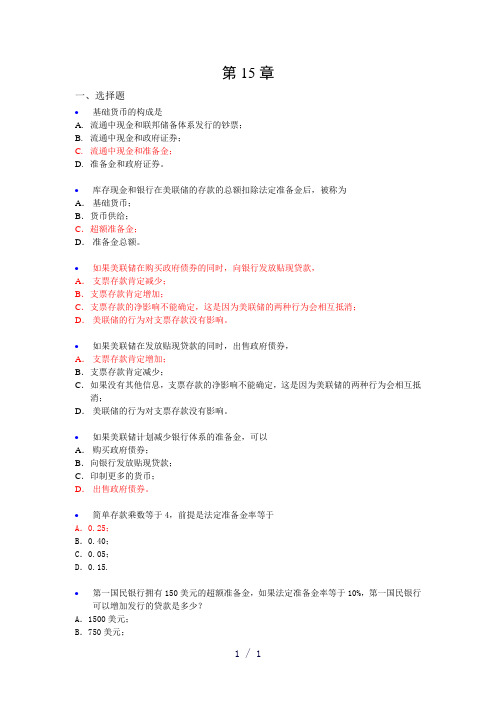
第15章一、选择题•基础货币的构成是A.流通中现金和联邦储备体系发行的钞票;B.流通中现金和政府证券;C.流通中现金和准备金;D.准备金和政府证券。
•库存现金和银行在美联储的存款的总额扣除法定准备金后,被称为A.基础货币;B.货币供给;C.超额准备金;D.准备金总额。
•如果美联储在购买政府债券的同时,向银行发放贴现贷款,A.支票存款肯定减少;B.支票存款肯定增加;C.支票存款的净影响不能确定,这是因为美联储的两种行为会相互抵消;D.美联储的行为对支票存款没有影响。
•如果美联储在发放贴现贷款的同时,出售政府债券,A.支票存款肯定增加;B.支票存款肯定减少;C.如果没有其他信息,支票存款的净影响不能确定,这是因为美联储的两种行为会相互抵消;D.美联储的行为对支票存款没有影响。
•如果美联储计划减少银行体系的准备金,可以A.购买政府债券;B.向银行发放贴现贷款;C.印制更多的货币;D.出售政府债券。
•简单存款乘数等于4,前提是法定准备金率等于A.0.25;B.0.40;C.0.05;D.0.15.•第一国民银行拥有150美元的超额准备金,如果法定准备金率等于10%,第一国民银行可以增加发行的贷款是多少?A.1500美元;B.750美元;C.150美元;D.0美元。
•如果银行体系的超额准备金为75美元,法定准备金率为0.20,支票存款可能扩张A.75美元;B.750美元;C.37.50美元;D.375美元。
•美联储出售政府债券A.被称为公开市场出售;B.减少基础货币,其他都不变;C.增加流通中的现金,其他都不变;D.上述所有选项都正确;E.只有(A)与(B)正确。
•如果非银行公众用现金从联邦储备体系购买政府债券,那么,A.基础货币和准备金都减少;B.基础货币和准备金都增加;C.基础货币减少,准备金保持不变;D.基础货币减少,流通中的现金保持不变;E.上述都不正确。
•下列哪种属于联邦储备体系的资产?A.财政债券;B.财政存款;C.贴现贷款;D.(A)与(B)正确;E.(A)与(C)正确。
武汉大学货币金融学习题册及答案,DOC
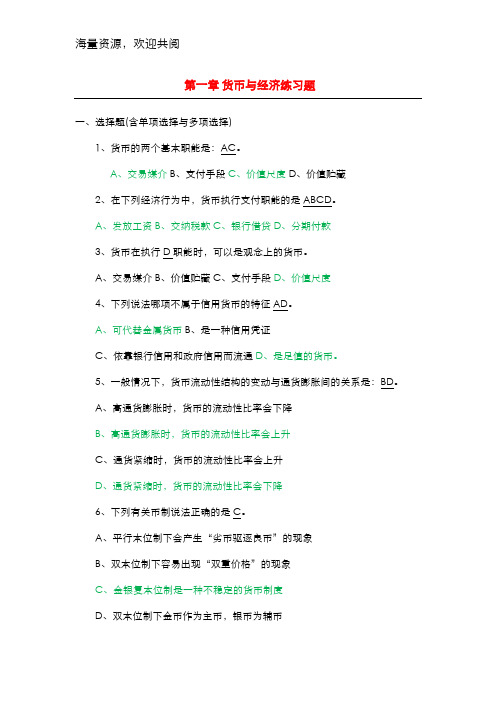
第一章货币与经济练习题一、选择题(含单项选择与多项选择)1、货币的两个基本职能是:AC。
A、交易媒介B、支付手段C、价值尺度D、价值贮藏2、在下列经济行为中,货币执行支付职能的是ABCD。
A、发放工资B、交纳税款C、银行借贷D、分期付款3、货币在执行D职能时,可以是观念上的货币。
A、交易媒介B、价值贮藏C、支付手段D、价值尺度4、下列说法哪项不属于信用货币的特征AD。
A、可代替金属货币B、是一种信用凭证C、依靠银行信用和政府信用而流通D、是足值的货币。
5、一般情况下,货币流动性结构的变动与通货膨胀间的关系是:BD。
A、高通货膨胀时,货币的流动性比率会下降B、高通货膨胀时,货币的流动性比率会上升C、通货紧缩时,货币的流动性比率会上升D、通货紧缩时,货币的流动性比率会下降6、下列有关币制说法正确的是C。
A、平行本位制下会产生“劣币驱逐良币”的现象B、双本位制下容易出现“双重价格”的现象C、金银复本位制是一种不稳定的货币制度D、双本位制下金币作为主币,银币为辅币7、实物货币形态中被人们选择作为货币的商品必须具有ABCD的特性:A、价值含量较大B、易于保存C、容易分割D、人们都乐于接受8、信用货币具有的特征是ABD:A、是价值符号B、是负债货币C、可以任意发行D、国家强制性9、价值尺度与价格标准的区别在于ABCD:A、内在与外在B、目的与手段C、自发与人为规定D、变化不一样10、货币危机性最大的职能是B:A、通手手段B、支付手段C、贮藏手段D、国际货币11、我国的货币层次划分中一般将现金划入A层次:A、M0B、M1C、M2D、M312、货币层次控制重点的确定原则有ABC:A、相关性B、可测性C、可控性D、流动性13、虚金本位制也叫D:A、金币本位制B、金块本位制C、生金本位制D、金汇兑本位制14、金银复合本位制的主要缺陷是ABC:A、造成价值尺度的多重性B、违反独占性和排他性C、引起兑换比率的波动D、导致币材的匮乏15、金银复本位制向金本位制的过渡方式是C。
米什金货币银行学第九版中文课后题答案
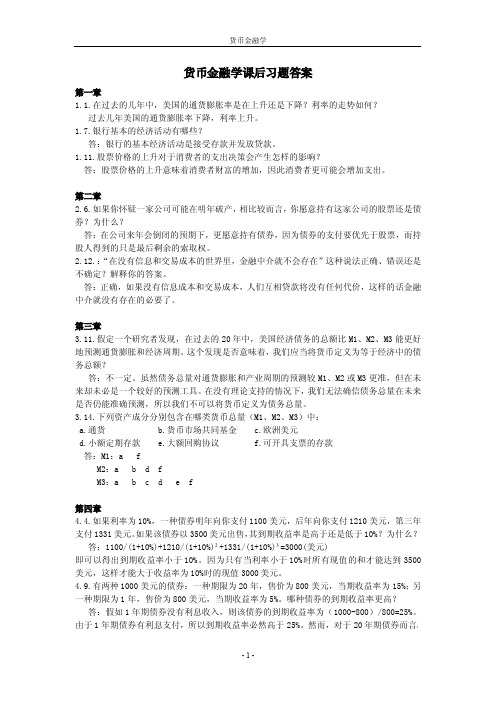
- 1、下载文档前请自行甄别文档内容的完整性,平台不提供额外的编辑、内容补充、找答案等附加服务。
- 2、"仅部分预览"的文档,不可在线预览部分如存在完整性等问题,可反馈申请退款(可完整预览的文档不适用该条件!)。
- 3、如文档侵犯您的权益,请联系客服反馈,我们会尽快为您处理(人工客服工作时间:9:00-18:30)。
一、填空题1、我国金融业目前已经形成了是以为核心,为主体,各种金融机构并存的格局。
2、目前我国的三家金融监管机构是、和。
3、美国于1933年制定了,确立了商业银行与投资银行分业经营的局面;1999年通了,彻底拆除了银行、证券和保险业之间的藩篱,标志着的终结,以为基础的现代金融制度的确立。
二、单项选择题1、下列金融机构中属于存款性金融机构的是。
A、中国邮政储蓄银行B、富国投资公司C、易方达货币市场基金D、东盛汽车租赁公司2、下列不以盈利为经营目的的金融机构是。
A、商业银行B、储蓄银行C、政策性银行D、投资银行3、当前我国金融业实行的经营体制是。
A、混业经营B、分业经营C、统一管理D、混业管理4、间接融资中资金的最终供需双方。
A、要发生直接借贷关系B、需要通过金融中介机构发生直接联系C、不发生直接联系D、需求方要签发自己的债务凭证给资金的最终供给方。
5、直接融资的投资收益与间接融资收益相比较一般。
A、要高B、要低C、持平D、不确定三、多选题1、间接融资的主要优点有()。
A、减少获取信息和合约的成本B、可以通过投资的多样化而减少风险C、资金盈余单位承担的风险较高D、对资金盈余单位的投资专业知识和技能要求较高E、可以实现资金期限的转移2、金融体系中资金融通的渠道主要有()。
A、国际融资B、直接融资C、债券融资D、间接融资E、股权融资3、下列机构有哪些是金融机构()。
A、保险公司B、中央银行C、合作社D、养老基金E、互助储蓄机构。
四、简述题1、简述我国金融体系的基本格局。
2、试比较直接融资和间接融资的区别。
3、从银行角度分析金融业混业经营的优势。
五、判断题1、直接融资成本与资金融入方的信用无关。
()2、我国的金融监管体系是按照分业管理的要求设立的。
()3、直接融资就是指以金融机构作为信用中介而进行的融资。
()4、.政策性银行也称政策性专业银行,不以盈利为经营目标。
()一、填空题1.按交易标的物划分,金融市场分为、资本市场、外汇市场和。
2.按交易层次划分,金融市场分为和。
3.金融市场的交易对象是。
4、衡量一国金融市场是否成熟的三个标准分别是广度、深度与。
5、回购协议实质上是一种以为质押品的短期融资活动。
6、金融期货市场的功能有两个,分别是套期保值和。
二、单项选择题1、下列那种不属于间接融资( )。
A、你从当地银行申请抵押贷款B、保险公司借款给联想公司C、你从好友处借得1000元D、你购买共同基金的份额;2、按交易对象的不同,金融市场可分为 ( )。
A、债券市场和股权市场B、一级市场和二级市场C、货币市场和资本市场D、场内交易市场和场外交易市场3、对已发行的证券进行买卖,转让的市场称为()。
A、一级市场B、二级市场C、现货市场D、资本市场4.如果你计划的投资期限不超过1年,你最可能投资于下列哪个市场?( )A、一级市场B、资本市场C、货币市场D、场外市场5、同业拆借市场是金融机构之间为()而相互融通的市场。
A、减少风险B、提高流动性C、增加收入D、调剂短期资金余缺6、()已成为我国金融机构进行流动性管理的最重要的场所。
A、股票市场B、债券回购市场C、同业拆借市场D、票据市场7、大额可转让定期存单是由()首先发行的。
A、美国联邦银行B、纽约花旗银行C、英格兰银行D、日本银行8、公司在发行债券时,发行价格等于债券面额,这种发行是()。
A、市价发行B、平价发行C、中间价发行D、溢价发行9、在出售证券时与购买者约定到期买回证券的方式称为()。
A、证券发行B、证券承销C、期货交易D、回购协议10、属于整个证券市场的主体和核心的流通市场是()。
A、场外交易市场B、第四市场C、证券交易所D、第三市场三、多选题1.金融市场的参与者有 ( )。
A.居民个人 B.商业性金融机构 C.政府 D.企业 E.中央银行2.与货币市场相比,资本市场()。
A.流动性更强 B.交易期限较长的金融工具 C.价格波动较大D.收益率较高 E.上述所有选项都正确3.货币市场的主要交易对象有()。
A.大额可转让存单 B.商业票据 C.同业拆借 D.长期政府债券E.银行承兑汇票4.国库券市场的特点有()。
A.安全性高 B. 流动性强 C. 较高的税负 D 期限长 E. 大面额交易5、在流通市场上,参与国库券交易的有()A.商业银行 B.中央银行 C.证券交易商 D.企业 E.个人投资者6.关于大额存单的说法,正确的是()。
A.存单的产生是美国银行逃避利率管制的结果。
B.在美国。
存单的面额通常以100万美元为单位,初始偿还期为1到6个月。
C.存单以面额发行,到期还本付息。
D.存单的利率低于短期国债利率。
E.存单的利率有固定的、也有浮动的。
7.股票发行市场与流通市场的关系是()。
A.发行市场是基础,是前提。
B.流通市场是基础,是前提。
C.没有发行市场,就不会有流通市场。
D.没有流通市场,就不会有发行市场。
E.流通市场习不是无足轻重的,可有可无,它对发行市场有着重要的促进或推动作用。
四、简述题1、金融市场是如何发挥反映功能的?2、货币市场主要包括哪些子市场?3、简述同业拆借市场的特点和作用。
4、金融期货与金融期权有何区别?五、判断题1、同业拆借市场利率变化可以成为中央银行调整货币政策的重要参考指标。
()2、股票流通市场上的价格是反映经济动向的“晴雨表”。
()3、中央银行参与金融市场是以调节货币供应量为目的。
( )4、贴现银行持票据向其他银行申请贴现,称为再贴现。
( )5、公司制的证券交易所是不以盈利为目的的法人团体。
( )6、票据贴现实际上是将商业信用转化成了银行信用。
( )六、计算题1、某企业将6个月后到期,票面总额为10000元的商业票据贴现给银行,贴现率为6%,请问企业能够获得的资金是多少?支付给银行的利息是多少?2、某公司持有一张面额10000元的票据去银行办理贴现,该票据50天后到期,银行的年贴现率为12%,该公司可以从银行得到多少现款?3、某债券买入价99.65元,面额100元,还有9年到期,每年付息一次,利息率5%,计算直接收益率和到期收益率?第三章金融工具一、填空题1、股票是由股份公司发行的权益证券,代表持有者对公司资产和收益的。
2、根据投资基金的组织形式,可以分为和。
3、债务人的信用好,信用工具的流动性就,其收益率也往往较。
4、债券根据发行主体的不同,可分为、公司债券和金融债券三种债券。
5、根据出票人不同,汇票分为商业汇票和两种。
6、本票是对发出,承诺到期无条件支付款项的债务证书。
二、单选题1.金融工具的三个重要特征不包括()。
A.流动性 B.风险性 C.杠杆性 D.收益性2.一般而言,金融资产的流动性与风险性、收益性之间的关系存在( )。
A.正相关 B.负相关 C.不相关 D.不确定关系3.如果债券是以低于面值购买的,到期收益率要()当期收益率;如果债券是以高于面值购买的,到期收益率要()当前收益率;A.低于高于 B.高于等于 C.等于低于 D.高于低于4.下列不属于短期债务工具的是()。
A.商业票据 B.银行承兑汇票 C.公司债券 D.大额存单5.一张差半年到期的面额为2000元的国库券,如果它的发行价为1800元,则年贴现率为( )。
A.5% B.10% C.20% D.5.12%6.关于商业票据的描述,错误的是()。
A.商业票据是直接向货币市场投资者发行的无担保票据。
B.商业票据的信用质量高、期限较长。
C.在国际资本市场上已经成为很多公司短期资金的重要来源。
D.主要发行人是工业公司、金融公司、公共设施和银行持股公司。
7.优先股票的特征不包括()。
A.股息率固定 B.股息分派优先 C.剩余资产分配优先 D.具有优先认股权8.对于回购协议的说法错误的是()。
A.所涉及的证券主要是国债 B.回购协议交易流动性强,安全性高C.回购协议收益低于银行存款收益 D.是融通短期资金的行为9.我国发行的政府债券不包括()。
A.凭证式国债 B.记名国债 C.不记名国债 D.记账式国债10.地方政府债券有其独特的特点,与公司债相比,二者的一个重要的区别是()。
A.发行者 B.偿还担保 C.免税 D.发行方式11.可转换债券具有()双重特性。
A.债券和期权 B.债权和股权 C.债权和权证 D.股权和期权12.通常被称为“金边债券”的是()。
A.金融债券 B.政府债券 C.公司债券 D.可转换公司债券13.金融期货合约的特点不包括()。
A.标准化 B.可转让 C.即期交割 D.具有杠杆性14.金融期货种类很多,下面不属于金融期货的有()。
A.利率期货 B.外汇期货 C.股票指数期货 D.大豆期货三、多选题1.以下属于长期融通工具主要有( )。
A.公司债券B.政府债券C.股票D.银行票据E. 商业票据2.关于回购协议的叙述,正确的有()。
A.回购协议是一种短期融资的方式 B.标的物是有价证券C.回购协议市场的交易流动性强,安全性高 D.收益稳定且超过银行存款收益E.商业银行利用回购协议融入的资金要交纳存款保证金3.股票具有的特征包括()。
A. 收益性B. 风险性C. 流通性D. 参与性E. 不可偿还性4.债券与股票的区别有()。
A. 投资主体不同B. 期限不同C. 收益不同D. 风险不同E. 反映的经济关系不同5.按股票所代表的股东权利划分,股票可分为( )。
A. 记名股B. 优先股C. 不记名股D. 新股E. 普通股6.关于优先股票的论述正确的是()。
A.优先股票也是一种没有期限的所有权凭证。
B.相对于普通股票而言,再分配红利和剩余财产时有优先权。
C.优先股也有选举权和被选举权。
D.优先股票事先确定固定的股息率,像债券的利息率事先固定一样。
E .上面的表述都正确。
7.下面金融工具中属于衍生工具的有()。
A.远期 B.期货 C.期权 D.优先股 E.互换8.与金融远期合约相比,金融期货合约的特点是()。
A.指定交易所 B.合约标准化 C.保证金与逐日结算 D.结束头寸的方法E.不同的交易参与者四、简述题1、请分析金融工具的特性。
2、简述主要的货币市场工具。
3、简述主要的资本市场工具。
4、试述金融期货和远期合约的区别。
5、简述金融衍生工具的特点。
第四章货币与货币制度一、填空题1、在货币产生的过程中,商品价值形式的发展经过、、、等四个阶段。
2、货币在表现和衡量商品价值时,货币执行职能;在商品的赊销赊购过程,货币执行职能;在退出流通时执行职能;在世界市场上发挥一般等价物作用时执行职能。
3、在跛行本位制下,可以自由铸造而不能自由铸造。
4、人民币的发行权属于,是全国惟一的货币发行机关。
5、存储于银行电子计算机系统内可利用银行卡随时提取现金或支付的存款货币称为。
二、单选题1.商品价值形式最终演变的结果是发行了。
